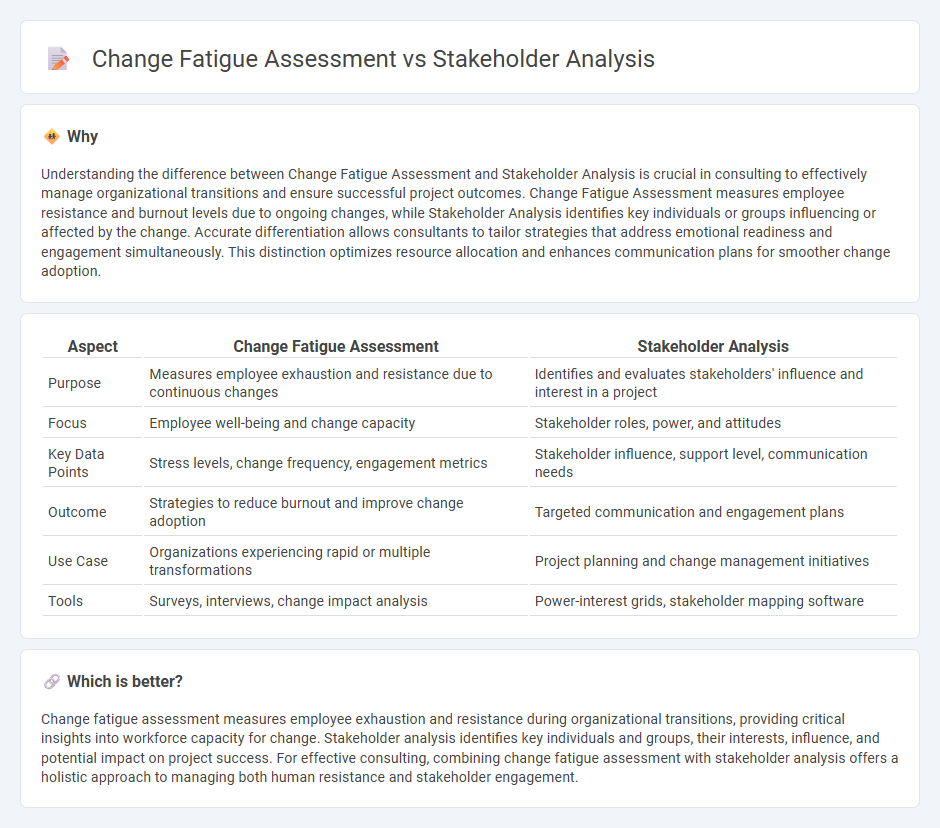
Change fatigue assessment measures employees' resistance and burnout during organizational transitions, providing insights into readiness and potential barriers. Stakeholder analysis identifies key individuals or groups affected by change, evaluating their influence, interest, and support to tailor communication strategies effectively. Discover how combining these tools enhances successful change management by understanding both emotional impacts and stakeholder dynamics.
Why it is important
Understanding the difference between Change Fatigue Assessment and Stakeholder Analysis is crucial in consulting to effectively manage organizational transitions and ensure successful project outcomes. Change Fatigue Assessment measures employee resistance and burnout levels due to ongoing changes, while Stakeholder Analysis identifies key individuals or groups influencing or affected by the change. Accurate differentiation allows consultants to tailor strategies that address emotional readiness and engagement simultaneously. This distinction optimizes resource allocation and enhances communication plans for smoother change adoption.
Comparison Table
| Aspect | Change Fatigue Assessment | Stakeholder Analysis |
|---|---|---|
| Purpose | Measures employee exhaustion and resistance due to continuous changes | Identifies and evaluates stakeholders' influence and interest in a project |
| Focus | Employee well-being and change capacity | Stakeholder roles, power, and attitudes |
| Key Data Points | Stress levels, change frequency, engagement metrics | Stakeholder influence, support level, communication needs |
| Outcome | Strategies to reduce burnout and improve change adoption | Targeted communication and engagement plans |
| Use Case | Organizations experiencing rapid or multiple transformations | Project planning and change management initiatives |
| Tools | Surveys, interviews, change impact analysis | Power-interest grids, stakeholder mapping software |
Which is better?
Change fatigue assessment measures employee exhaustion and resistance during organizational transitions, providing critical insights into workforce capacity for change. Stakeholder analysis identifies key individuals and groups, their interests, influence, and potential impact on project success. For effective consulting, combining change fatigue assessment with stakeholder analysis offers a holistic approach to managing both human resistance and stakeholder engagement.
Connection
Change fatigue assessment identifies employee resistance and stress levels during organizational transitions, which informs stakeholder analysis by highlighting key influencers and affected groups. Understanding stakeholder priorities and concerns enhances strategies to mitigate change fatigue. Effective integration of both processes ensures smoother change management and higher adoption rates.
Key Terms
**Stakeholder analysis:**
Stakeholder analysis identifies key individuals and groups impacted by or capable of influencing a project, mapping their interests, power, and attitudes to tailor communication and engagement strategies effectively. This process enhances decision-making by prioritizing stakeholder needs and managing potential resistance to change. Explore how stakeholder analysis drives project success and stakeholder alignment for deeper insights.
Power-Interest Grid
The Power-Interest Grid is a key tool in stakeholder analysis used to categorize stakeholders based on their level of authority and concern regarding a project, ensuring targeted communication and engagement strategies. In contrast, change fatigue assessment evaluates employee resistance and burnout during organizational transformations, focusing on psychological and emotional states rather than stakeholder positions. Explore how integrating these approaches can enhance change management effectiveness and stakeholder alignment.
Influence Mapping
Stakeholder analysis identifies key individuals or groups based on their influence and interest, enabling targeted communication and engagement strategies. Change fatigue assessment evaluates the resistance levels and stress caused by continuous organizational changes, helping to tailor interventions that reduce burnout. Explore how integrating influence mapping with change fatigue metrics optimizes change management outcomes.
Source and External Links
Stakeholder analysis - Wikipedia - Stakeholder analysis is a process used to identify and assess the interests and influence of relevant parties--stakeholders--to inform planning for projects, policies, or actions and ensure all affected parties are considered.
Stakeholder Analysis: Definition, Steps and Example | Indeed.com - Stakeholder analysis helps project managers and business owners determine each stakeholder's interest, influence, and potential impact, guiding communication, involvement, and expectation management throughout a project.
 dowidth.com
dowidth.com